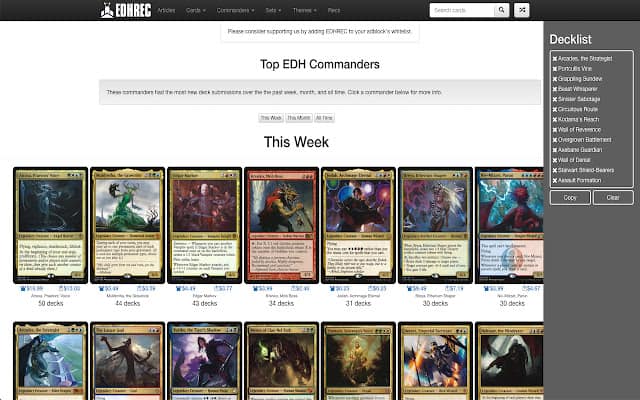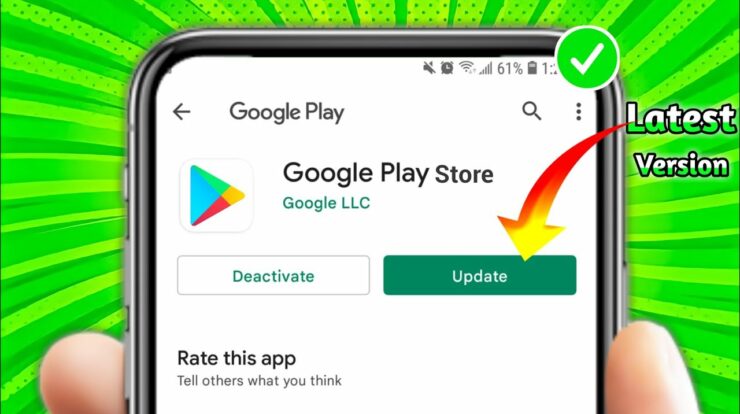
Commander is one of Magic’s most popular formats, and it’s the most popular for casual play. Some Commander players can design a fresh deck by looking at cards and making their own judgements, although the majority of players do not do so. They discuss cards and deck ideas with friends and playgroups, read articles, watch MTG content providers, and use internet tools such as EDHREC.
When creating a new Commander deck, EDHREC is a great place to start. What makes it special? How can you make use of it? Let us investigate!
What Is EDHREC, Exactly? Why Should You Use It?
EDHREC is an acronym that stands for “Elder Dragon Highlander REcommendations.” Before Wizards approved Commander as an official format in 2011, it was known as EDH. The moniker “EDH” is derived from the first legendary animals to captain the ship in 1994, the elder dragons, as well as fans of the film Highlander for the singleton building constraint (“There can only be one.”).
In the community, both EDH and Commander are used to refer to the same format. The reasons why Commander was picked instead of EDH are boring, legal, and don’t matter.
The primary goal of EDHREC is to provide a data-driven resource for deckbuilding in the Commander format. It keeps track of all potential commanders and the cards that may be used with them in order to assist players in choosing their “ideal” deck.
EDHREC draws card data from its own database, ScryFall (art, card stats, and mechanics), and Commander Spellbook (for combinations), as well as decklists from Aetherhub, Archidekt, Deckstats, Moxfield, and MTGGoldfish. If you create a public Commander deck on any of those sites, your deck adds to EDHREC’s numbers.
The major reason to use EDHREC is that it is a free resource that gathers a wealth of information to assist you in determining which cards work best in your deck depending on the mechanics you desire with specific commanders.
Examine Glissa, the traitor’s EDHREC page for the commander. One section discusses the lands that other players have used in their Glissa decks. Should you run it as well? That is determined by your desires, your budget, and what you feel is a good synergy with the topic you’re working toward. Without EDHREC collecting this information, you may overlook cards you were unaware of.
How to Make a Deck Using EDHREC
#1. Choose a Commander
There are several approaches to creating decks using EDHREC. You may have a certain commander in mind, a tribe for which you wish to construct, or simply a general concept in mind. One of my favourite methods is to choose a deck based on a desired combination.
You may reduce your selections by searching for the commander you want, a specific card from the 99 you want to build around, or even a certain colour combo you want to adhere to, using the “Search” tab at the top of the webpage. It can also help find partner commanders and people who will let you use a background.
If you have a certain theme in mind, you can find inspiration under the “Themes” menu. You may search for themes based on companions, themes, or even tribes. The top five themes and tribes are given in the menu, but you may sift through some more unusual ones by clicking on the parent option.
#2. Investigating the Commander’s Stats
- After you’ve chosen your commander or build-around card, you may examine its stats on its page:
- When it comes to the card’s stats, there are a few different ways to see them. “As Commander” displays the stats if you use the card as your commander, but “As Card” displays the stats if you use it as part of your 99. “Average Decks,” “Decks,” and “Combinations” provide an average deck based on the synergy ratings of the cards that go with it, a list of decks used as a foundation for EDHREC’s ratings, and any combos that typically exist in the colours for this commander.
- “Average Type Distribution” provides a breakdown of the card types found in a typical deck for this commander. You can use this as a reference for deck composition ratio considerations.
- “Average Mana Curve” is the average mana curve for this commander’s deck. It’s useful when considering the mana base and if the ramp should be included.
- Most commanders may serve as the cornerstone for a variety of strategies. The Raidmother may be used as the head of a goblin tribe, although it’s best suited for a spellslinger deck. Changing the theme alters the recommendations provided by the page. “By Budget” makes suggestions based on how much you can spend, while “All” is a balanced setting that puts synergy ahead of cost.
- “Top Combos” is another way to access the commander’s “Combos” page. It normally displays three of the most popular deck combinations that fit the subject, but it may not display anything if no combo fits the theme.
#3. The 99
Recommendations for Cards
When you’re trying to add particular sorts of cards to your deck, you can get some ideas from the card suggestions underneath the card’s stats. All areas are dynamic and alter as new decks are added to the evaluations and ratings. However, keep the following in mind:
- “New Cards” displays the cards from the most recent release that correspond to the colours and theme.
- “High Synergy Cards” integrate the card’s synergy with the theme and only display cards with the highest synergy regardless of card type (creatures, enchantments, sorceries, etc.).
Card Statistics
- Each suggested card has the following essential information:
- A picture of the card
- Card Kingdom, TCGPlayer, and CoolStuffInc. have current market pricing.
- The proportion of decks with the specified theme that contain the card.
- The card’s synergy rating in the chosen theme
The word of the day is synergy! It’s not just a business phrase in Magic; it’s the lifeblood of every Commander deck and what distinguishes each theme and tribe. As you evaluate cards, the synergy number will inform you as to their usefulness. The higher the proportion, the better.
Cards have been copied to your clipboard.
EDHREC assists you in keeping track of the cards you want in your decklist. A paperclip with a number is located in the upper right corner, near the search bar. This is your clipboard, and it is where EDHREC keeps track of any cards you wish it to.
How do you get the cards in? When you hover over a card, a plus (+) appears in the top left corner of the picture. When you click the plus sign, the card is copied to your clipboard.
#4. Making Cuts
How do you decide what to eliminate and what to keep now that you know how to design a fresh deck? EDHREC provides what I call a “straight suggestion.” You may access these by selecting Recs in the main toolbar.
On this page, you can put in your commander and decklist. EDHREC will then look through the active recommendations and tell you which cards to take out and which to add.
How to Add Your Deck to EDHREC
Decklists are retrieved from Aetherhub, Archidekt, Deckstats, Moxfield, and MTGGoldfish by EDHREC. If you create a legal, public Commander deck on any of those websites, your deck will aid in the calculation of statistics. The API that does this pull also keeps track of which decks are used. When you update a deck on one of these sites, EDHREC removes all references to the old one and replaces it with the new one.
However, nothing is perfect. It’s an automated link, although certain cards may slip through the cracks. Expect to see the number of decks or synergy score for a card change after creating a deck. It will very certainly be drawn in and used someday, albeit perhaps not immediately.
On EDHREC, how is synergy calculated?
Dragon Fodder and Krenko’s Command are two cards that are almost similar in every way. They both have the same effect, mana cost, and card type. Their synergies, however, are distinct. This is due to the actual calculation used to calculate the synergy score:
(Percentage of decks containing this card for this commander/theme)- (Percentage of decks in which this card appears for colour identification)
Command has a lower ranking simply because it is older and appears in more red decks than Fodder. This equation is also there to help deckbuilders with core cards like Sol Ring and Command Tower.
What is your “salt score”?
“Salt” or “salty” refers to unpleasant thoughts regarding a specific card. The “salt scores” are the results of an annual survey administered by EDHREC to its users. Users are shown a single card and asked to rate its “saltiness” on a scale of 0 to 4. The findings are calculated, and each card is assigned a salt score.
The score is intended to help deckbuilders predict how angry their opponents will be with a certain card or with their whole deck. The higher the rating, the saltier the dish. These are the top five saliest cards right now:
- Stasis
- Winter’s Orb
- Orb Static
- Hunger’s Voice, Vorinclex,
- Expropriate
This score does not imply that you should not use the card or that it is ineffective. Expropriate may be found in over 20,000 decks in the database. It’s merely a heads-up about what may happen and how your deck might be seen by people around you.
The rest of the list is available here for anyone who is interested. A special note: #6-10 are all about land damage. Take it how you want.
Other Suggestions
One of the most important findings about EDHREC is that it is a significant departure from netdecking and more of a card warehouse. It’s a warehouse that appears to be run by Amazon rather than an LGS (in a data retention way).
Almost every aspect of a card is monitored, including which commanders are using it, how many decks are using it, which colour combinations are utilising it, and so on. With so much data, there’s always something to learn.
Sting Without the Glamour
Card prices are also gathered so that trends and their sources may be identified.
Assume you’re looking at the financial side of Magic and you see some unusual activity on a card. It’s not from a recent set, and it doesn’t appear to have any useful abilities. You can utilise EDHREC’s data to your advantage if you don’t want to fall behind.
You may check on the card and see if any trends are emerging, such as whether any of the newer commanders are beginning to employ the card. Perhaps you’d like to get your hands on the card before the price skyrockets. If you can’t find a pattern, you can assume that the rise in popularity is due to a change in another format’s meta due to a new release.
The Hivemind of EDHREC
A straight line in the opposite direction is the shortest distance between two places.
Webb, Ty (Chevy Chase)
A Commander deck can be built in a variety of ways. Every commander has numerous themes from which to build, so picking the correct one for you may be a bit different. Some make your brain twist trying to figure out how to make things operate in a specific way. This is where EDHREC’s pseudo-hivemind may help: others have come before you and developed these decks.
Codie, Vociferous Codex is a card that prevents you from employing creatures in order to utilise its other ability. It’s an excellent target for group hug cards like Fractured Identity, which players discovered very early following its reveal. It compels your opponents to deal with the spellcasting stumbling block rather than you.
I also had no clue you could customise Codie to be a cycling commander. The aim is to cycle a large number of creatures into the graveyard and then utilise mass excavation effects such as Living End to return them all to the battlefield. The coolest part is that you may cast it for free with Codie, Vociferous Codex’s ability by casting a one-mana instant or sorcery and searching for it.
Conclusion
EDHREC is a fantastic resource for general EDH knowledge as well as a helpful resource for deckbuilding. It gives you a lot of information about cards and tips based on what other players think and what they play.
Whether you’re developing a new deck or renovating an existing one, I strongly advise you to use EDHREC as an aggregator for crowd-sourced ideas. It’s less difficult than asking around at your LGS!
FAQS
What does Edhrec mean?
In fact, I’m willing to wager that none of you peons ever broke the code. EDHREC is not an acronym that stands for Elder Dragon Highlander Recommendations. It is an acronym that stands for “Everyone Dumbly Homogenizing my Ridiculously Expensive Cash-Cow.”
What websites does Edhrec use?
Deck data is gathered by EDHREC from Archidekt, MTGGoldfish, Aetherhub, CommanderSpellbook, Moxfield, Scryfall, and Deckstats. We often get information from these pages, and new information usually shows up on the pages within a few days.
How many decks does Edhrec have?
In truth, it appears in just 32 decks. What exactly is this? Following: Sorted by EDHREC Rank Cards that are often used in Commander may be found here.












